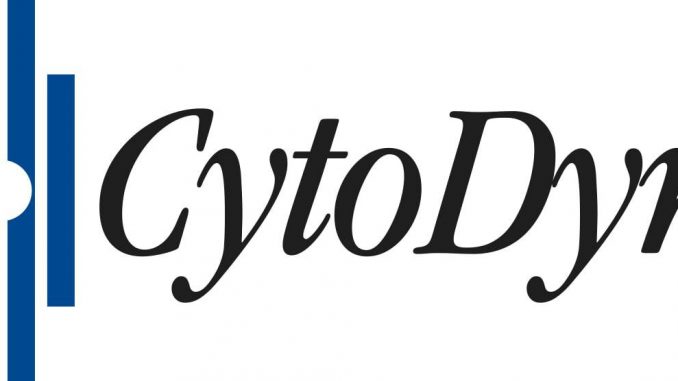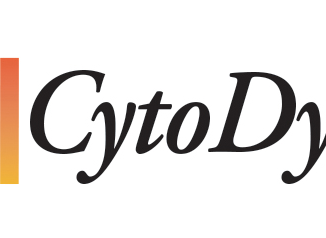
VANCOUVER, Washington, Feb. 14, 2020 — CytoDyn Inc. (otc.qb:CYDY), (“CytoDyn” or the “Company”), a late-stage biotechnology company developing leronlimab (PRO 140), a CCR5 antagonist with the potential for multiple therapeutic indications, announced today continued positive data for its mTNBC and MBC patients.
Metastatic triple-negative breast cancer (mTNBC), an aggressive histological subtype, has a poor prognosis. In addition, metastatic breast cancer (MBC) is breast cancer that has spread beyond the breast and lymph nodes to other organs in the body (typically the bones, liver, lungs, or brain). Both types of cancer pose significant challenges for patients due to their aggressiveness and limited treatment options. An integral part of CytoDyn’s mission and purpose is to provide effective therapeutic solutions to these patients. Results of the first five patients are as follows:
Patient #1: Enrolled in mTNBC Phase 1b/2 – Injected on 9/27/2019. CTC (circulating tumor cells) dropped to zero in two weeks on 10/11/2019. Total CTC and EMT (Epithelial Mesenchymal Transition in Tumor Metastasis) dropped to zero after about one month of treatment with leronlimab (once-a-week 350 mg dose). After approximately four months of treatment with leronlimab and Carboplatin, the patient had zero CTC+EMT. Furthermore, the patient’s CT scan indicated a 20% tumor shrinkage within the first few weeks of treatment with leronlimab.
Patient #2: Enrolled in single IND. Patient is MBC with HER2+ stage 4 metastasis to lung, liver, and brain. Patient’s radiologist cancelled 2 [nd] round of treatment due to leronlimab’s effect on shrinking the largest tumor in the brain by 56% and other lesions being stable. Leronlimab has, and continues to be, the only treatment in place since the measurement of brain tumor shrinkage was initiated. Patient was permitted to obtain CTC+EMT test results. After 10 weeks of treatment with leronlimab, this patient’s CTC+EMT results were zero (results reported on 2/12/2020).
Patient #3: Enrolled on 1/3/2020. This patient’s CAML counts went down from 45 to 30. CTC+EMT are stable and there has been no change in the total number.
Patient #4: Enrolled on 1/7/2020. This patient’s total CTC+EMT dropped by 75% in the first two weeks of treatment with leronlimab.
Patient #5: Enrolled on 2/4/2020. This patient’s CTC+EMT have been recorded upon enrollment and the first results are expected on 2/25/2020.
In addition to the first five patients, enrollment and treatment updates in CytoDyn’s Phase 2 protocol basket trial under its cancer IND are as follows:
Patient #6: Injected on 2/8/2020 and the first results since enrollment are due by end of February.
Patient #7: Injected on 2/13/2020.
Patients #8, 9 and 10: Completed screening for enrollment.
“The patients enrolled in the mTNBC Phase 1b/2 trial continue to demonstrate meaningful results that support the hypothesis regarding leronlimab’s mechanism of action,” said Bruce Patterson, M.D., chief executive officer and founder of IncellDx, a diagnostic partner and an advisor to CytoDyn. “In the four patients (1 with MBC, 3 with TNBC) now with results from leronlimab therapy, patients #1-3 have zero CTCs and zero EMTs and Patient #4, who has been treated with leronlimab for 2 weeks showed a decrease of CTCs and EMTs from 8 to 2. New data from Patient #2 with Stage 4 MBC and who has been treated with 10 weekly doses of leronlimab showed zero CTCs and zero EMTs, in addition to the shrinkage or disappearance of some brain metastases as previously reported.”
Nader Pourhassan, Ph.D., president and chief executive officer of CytoDyn, added: “These findings are extremely promising in light of the success rate of other treatment options. Therapeutic options for patients suffering from breast cancer are highly limited and we look forward to continuing enrollment and exploring leronlimab’s potential to treat this devastating disease. Since our basket trial for all solid tumor cancers has been initiated, we are currently screening a prostate cancer patient, and if continued positive clinical results are forthcoming from this patient, we are hopeful that this will clear the path for CytoDyn to file for Breakthrough Therapy designation for all solid tumor cancers. Our mechanism of action is not only focused on the inhibition of metastasis of solid tumor cancers, but also targets the tumor itself through macrophages, angiogenesis and T-reg.”
About Triple-Negative Breast Cancer
Triple-negative breast cancer (TNBC) is a type of breast cancer characterized by the absence of the three most common types of receptors in the cancer tumor known to fuel most breast cancer growth-estrogen receptors (ER), progesterone receptors (PR) and the hormone epidermal growth factor receptor 2 (HER-2) gene. TNBC cancer occurs in about 10 to 20 percent of diagnosed breast cancers and can be more aggressive and more likely to spread and recur. Since the triple-negative tumor cells lack these receptors, common treatments for breast cancer such as hormone therapy and drugs that target estrogen, progesterone, and HER-2 are ineffective.
About Leronlimab (PRO 140)The U.S. Food and Drug Administration (FDA) have granted a “Fast Track” designation to CytoDyn for two potential indications of leronlimab for deadly diseases. The first as a combination therapy with HAART for HIV-infected patients and the second is for metastatic triple-negative breast cancer. Leronlimab is an investigational humanized IgG4 mAb that blocks CCR5, a cellular receptor that is important in HIV infection, tumor metastases, and other diseases including NASH. Leronlimab has successfully completed nine clinical trials in over 800 people, including meeting its primary endpoints in a pivotal Phase 3 trial (leronlimab in combination with standard antiretroviral therapies in HIV-infected treatment-experienced patients).
In the setting of HIV/AIDS, leronlimab is a viral-entry inhibitor; it masks CCR5, thus protecting healthy T cells from viral infection by blocking the predominant HIV (R5) subtype from entering those cells. Leronlimab has been the subject of nine clinical trials, each of which demonstrated that leronlimab can significantly reduce or control HIV viral load in humans. The leronlimab antibody appears to be a powerful antiviral agent leading to potentially fewer side effects and less frequent dosing requirements compared with daily drug therapies currently in use.
In the setting of cancer, research has shown that CCR5 plays an important role in tumor invasion and metastasis. Increased CCR5 expression is an indicator of disease status in several cancers. Published studies have shown that blocking CCR5 can reduce tumor metastases in laboratory and animal models of aggressive breast and prostate cancer. Leronlimab reduced human breast cancer metastasis by more than 98% in a murine xenograft model. CytoDyn is therefore conducting a Phase 1b/2 human clinical trial in metastatic triple-negative breast cancer and was granted Fast Track designation in May 2019. Additional research is being conducted with leronlimab in the setting of cancer and NASH with plans to conduct additional clinical studies when appropriate.
The CCR5 receptor appears to play a central role in modulating immune cell trafficking to sites of inflammation and may be important in the development of acute graft-versus-host disease (GvHD) and other inflammatory conditions. Clinical studies by others further support the concept that blocking CCR5 using a chemical inhibitor can reduce the clinical impact of acute GvHD without significantly affecting the engraftment of transplanted bone marrow stem cells. CytoDyn is currently conducting a Phase 2 clinical study with leronlimab to further support the concept that the CCR5 receptor on engrafted cells is critical for the development of acute GvHD and that blocking this receptor from recognizing certain immune signaling molecules is a viable approach to mitigating acute GvHD. The FDA has granted “orphan drug” designation to leronlimab for the prevention of GvHD.
About CytoDynCytoDyn is a biotechnology company developing innovative treatments for multiple therapeutic indications based on leronlimab, a novel humanized monoclonal antibody targeting the CCR5 receptor. CCR5 appears to play a key role in the ability of HIV to enter and infect healthy T-cells. The CCR5 receptor also appears to be implicated in tumor metastasis and in immune-mediated illnesses, such as GvHD and NASH. CytoDyn has successfully completed a Phase 3 pivotal trial with leronlimab in combination with standard antiretroviral therapies in HIV-infected treatment-experienced patients. CytoDyn plans to seek FDA approval for leronlimab in combination therapy and plans to complete the filing of a Biologics License Application (BLA) in the first quarter of 2020 for that indication. CytoDyn is also conducting a Phase 3 investigative trial with leronlimab as a once-weekly monotherapy for HIV-infected patients and plans to initiate a registration-directed study of leronlimab monotherapy indication, which if successful, could support a label extension. Clinical results to date from multiple trials have shown that leronlimab can significantly reduce viral burden in people infected with HIV with no reported drug-related serious adverse events (SAEs). Moreover, results from a Phase 2b clinical trial demonstrated that leronlimab monotherapy can prevent viral escape in HIV-infected patients, with some patients on leronlimab monotherapy remaining virally suppressed for more than five years. CytoDyn is also conducting a Phase 2 trial to evaluate leronlimab for the prevention of GvHD and a Phase 1b/2 clinical trial with leronlimab in metastatic triple-negative breast cancer. More information is at www.cytodyn.com.
Forward-Looking Statements This press release contains certain forward-looking statements that involve risks, uncertainties and assumptions that are difficult to predict. Words and expressions reflecting optimism, satisfaction or disappointment with current prospects, as well as words such as “believes,” “hopes,” “intends,” “estimates,” “expects,” “projects,” “plans,” “anticipates” and variations thereof, or the use of future tense, identify forward-looking statements, but their absence does not mean that a statement is not forward-looking. The Company’s forward-looking statements are not guarantees of performance, and actual results could vary materially from those contained in or expressed by such statements due to risks and uncertainties including: (i) the sufficiency of the Company’s cash position, (ii) the Company’s ability to raise additional capital to fund its operations, (iii) the Company’s ability to meet its debt obligations, if any, (iv) the Company’s ability to enter into partnership or licensing arrangements with third parties, (v) the Company’s ability to identify patients to enroll in its clinical trials in a timely fashion, (vi) the Company’s ability to achieve approval of a marketable product, (vii) the design, implementation and conduct of the Company’s clinical trials, (viii) the results of the Company’s clinical trials, including the possibility of unfavorable clinical trial results, (ix) the market for, and marketability of, any product that is approved, (x) the existence or development of vaccines, drugs, or other treatments that are viewed by medical professionals or patients as superior to the Company’s products, (xi) regulatory initiatives, compliance with governmental regulations and the regulatory approval process, (xii) general economic and business conditions, (xiii) changes in foreign, political, and social conditions, and (xiv) various other matters, many of which are beyond the Company’s control. The Company urges investors to consider specifically the various risk factors identified in its most recent Form 10-K, and any risk factors or cautionary statements included in any subsequent Form 10-Q or Form 8-K, filed with the Securities and Exchange Commission. Except as required by law, the Company does not undertake any responsibility to update any forward-looking statements to take into account events or circumstances that occur after the date of this press release.

